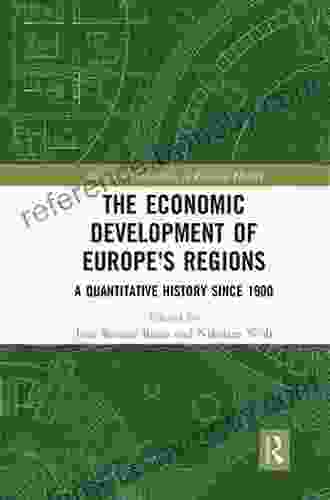Fortress Europe: A Historical Perspective on the European Union's Migration Policies

The European Union (EU) is often seen as a fortress, keeping out migrants from poorer countries. This image is reinforced by the EU's strict bFree Download controls, its detention centers for undocumented migrants, and its policies of repatriation and deportation.
5 out of 5
| Language | : | English |
| File size | : | 4472 KB |
| Text-to-Speech | : | Enabled |
| Screen Reader | : | Supported |
| Enhanced typesetting | : | Enabled |
| Word Wise | : | Enabled |
| Print length | : | 708 pages |
However, the EU's migration policies are not new. They have a long history, dating back to the early days of the European Economic Community (EEC). In this book, we will explore the historical development of the EU's migration policies, from the early days of the EEC to the present day. We will examine the political, economic, and social factors that have shaped these policies, and the impact they have had on migration flows and the lives of migrants.
The Early Years of the EEC
The EEC was founded in 1957 by the Treaty of Rome. The treaty established a common market for goods, services, capital, and labor. However, there were no specific provisions on migration.
In the early years of the EEC, migration was largely unregulated. Workers from poorer countries, such as Italy, Spain, and Portugal, were free to move to richer countries, such as Germany and France. This migration helped to fuel the economic growth of the EEC.
However, in the late 1960s and early 1970s, the EEC began to experience a number of economic problems. These problems led to a rise in unemployment and a decline in economic growth. As a result, the EEC began to tighten its migration policies.
The 1970s and 1980s
In the 1970s and 1980s, the EEC adopted a number of measures to restrict migration. These measures included:
* The of quotas on the number of workers from non-EEC countries who could enter the EEC * The creation of a system of bFree Download controls to prevent undocumented migrants from entering the EEC * The establishment of detention centers for undocumented migrants * The adoption of policies of repatriation and deportation
These measures had a significant impact on migration flows. The number of migrants entering the EEC declined sharply. In addition, the number of undocumented migrants living in the EEC increased.
The 1990s and 2000s
In the 1990s and 2000s, the EEC underwent a number of major changes. These changes included the adoption of the Schengen Agreement, the creation of the European Union, and the enlargement of the EU to include new member states from Central and Eastern Europe.
These changes led to a number of new challenges for the EU's migration policies. The Schengen Agreement created a bFree Downloadless area within the EU, making it easier for migrants to move between member states. The creation of the EU led to a new focus on human rights, including the rights of migrants. The enlargement of the EU to include new member states from Central and Eastern Europe led to a new wave of migration.
In response to these challenges, the EU adopted a number of new measures to manage migration. These measures included:
* The creation of a common asylum system * The establishment of a European BFree Download and Coast Guard Agency * The adoption of a new approach to integration, focusing on the rights and responsibilities of migrants
These measures have had a mixed impact. The common asylum system has helped to improve the treatment of asylum seekers. The European BFree Download and Coast Guard Agency has helped to reduce the number of undocumented migrants entering the EU. The new approach to integration has helped to improve the lives of migrants.
The EU's migration policies have a long and complex history. These policies have been shaped by a number of factors, including economic, political, and social factors. The impact of these policies has been mixed. They have helped to reduce the number of undocumented migrants entering the EU. They have also helped to improve the treatment of asylum seekers. However, they have also made it more difficult for migrants to move to the EU and have led to the creation of a system of detention and deportation.
As the EU continues to face new challenges, it will need to develop new policies to manage migration. These policies will need to be based on a fair and humane approach to migration. They will also need to be effective in reducing the number of undocumented migrants entering the EU and in improving the lives of migrants.
5 out of 5
| Language | : | English |
| File size | : | 4472 KB |
| Text-to-Speech | : | Enabled |
| Screen Reader | : | Supported |
| Enhanced typesetting | : | Enabled |
| Word Wise | : | Enabled |
| Print length | : | 708 pages |
Do you want to contribute by writing guest posts on this blog?
Please contact us and send us a resume of previous articles that you have written.
 Book
Book Novel
Novel Page
Page Chapter
Chapter Text
Text Story
Story Genre
Genre Reader
Reader Library
Library Paperback
Paperback E-book
E-book Magazine
Magazine Newspaper
Newspaper Paragraph
Paragraph Sentence
Sentence Bookmark
Bookmark Shelf
Shelf Glossary
Glossary Bibliography
Bibliography Foreword
Foreword Preface
Preface Synopsis
Synopsis Annotation
Annotation Footnote
Footnote Manuscript
Manuscript Scroll
Scroll Codex
Codex Tome
Tome Bestseller
Bestseller Classics
Classics Library card
Library card Narrative
Narrative Biography
Biography Autobiography
Autobiography Memoir
Memoir Reference
Reference Encyclopedia
Encyclopedia Anya Kamenetz
Anya Kamenetz Aimee Song
Aimee Song Angelo Lowery
Angelo Lowery Alaya Books
Alaya Books Andrew Gurr
Andrew Gurr Aine Homer
Aine Homer Adrian Gonzales
Adrian Gonzales Nicholas Crouch
Nicholas Crouch Casey Sherman
Casey Sherman Leon Z Surmelian
Leon Z Surmelian Jerald E Pinto
Jerald E Pinto Al Baird
Al Baird Adeyemi Jesutomisin
Adeyemi Jesutomisin Shandra Nalia
Shandra Nalia Alana Chernila
Alana Chernila Aleister Crowley
Aleister Crowley Gail Anthea Brown
Gail Anthea Brown Ian Mcewan
Ian Mcewan Michael Darlow
Michael Darlow Alan Laycock
Alan Laycock
Light bulbAdvertise smarter! Our strategic ad space ensures maximum exposure. Reserve your spot today!

 Joseph ConradJourney to the Heart of the Alaskan Wilderness: A Review of "The Alaskan Haul...
Joseph ConradJourney to the Heart of the Alaskan Wilderness: A Review of "The Alaskan Haul... Jace MitchellFollow ·7.5k
Jace MitchellFollow ·7.5k Neal WardFollow ·7.2k
Neal WardFollow ·7.2k Leo TolstoyFollow ·18.4k
Leo TolstoyFollow ·18.4k Benjamin StoneFollow ·3.6k
Benjamin StoneFollow ·3.6k Dion ReedFollow ·17.7k
Dion ReedFollow ·17.7k Angelo WardFollow ·10.8k
Angelo WardFollow ·10.8k Joseph ConradFollow ·2.5k
Joseph ConradFollow ·2.5k Adrian WardFollow ·9.1k
Adrian WardFollow ·9.1k

 Brandon Cox
Brandon CoxStronger: Forty Days of Metal and Spirituality
A 40-day...

 Dustin Richardson
Dustin RichardsonDelve into the Gripping World of British Crime: DCI Kett...
Unveiling the Intricate Tapestries of Crime...

 Giovanni Mitchell
Giovanni MitchellTrue Wealth Starts In The Mind: Unleash Your Inner...
In the pursuit of...

 Duncan Cox
Duncan CoxPulse Pounding British Crime Thriller: DCI Kett Crime...
Prepare for...

 Dashawn Hayes
Dashawn HayesUnveiling the Unwavering Strength and Inspiring Journey...
In the annals of wrestling history, the name...
5 out of 5
| Language | : | English |
| File size | : | 4472 KB |
| Text-to-Speech | : | Enabled |
| Screen Reader | : | Supported |
| Enhanced typesetting | : | Enabled |
| Word Wise | : | Enabled |
| Print length | : | 708 pages |












